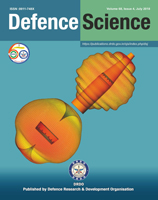Passive Thermal Management of Launch Vehicle Systems using Phase Changing Materials
DOI:
https://doi.org/10.14429/dsj.68.10433Keywords:
Hybrid heat sink, Thermal inertia, Phase changing materials, Fins, Transient thermal responseAbstract
Electronic systems in expendable launch vehicles and missiles rely on their own thermal inertia to operate for the stipulated time, without overheating, owing to absence of active cooling systems and natural convection at elevated altitude. Traditionally, this inertia is built-into the electronics by increasing its chassis (support structure) mass, proportional to the associated thermal load. For power intensive systems, especially in vehicle upper stages where mass is at premium, this approach results in reduction in payload capability. In the proposed paper, a Heat Sink based on Neopentyl Glycol (NPG) with solid-to-solid phase change (crystalline transformation) is explored as a mass effective alternative due to the material’s capability to absorb a significant amount of energy during phase change. However, due to its lower thermal conductivity, a Thermal Conductivity Enhancer (TCE) to maximize heat transfer had to be employed. The resulting heat sink, utilizing TCE for heat transfer capability and NPG for heat storage capability is called as Hybrid Heat Sink. A heat sink with plate type fins as TCE is realized and a mass reduction factor of 1.4 is achieved against traditional approach. This is followed by a heat sink with pin type fins as TCE where mass reduction factor is increased to 2.6. Effect of thermal cycling and vibration on its performance is also studied.
Downloads
Published
How to Cite
Issue
Section
License
 Where otherwise noted, the Articles on this site are licensed under Creative Commons License: CC Attribution-Noncommercial-No Derivative Works 2.5 India
Where otherwise noted, the Articles on this site are licensed under Creative Commons License: CC Attribution-Noncommercial-No Derivative Works 2.5 India


